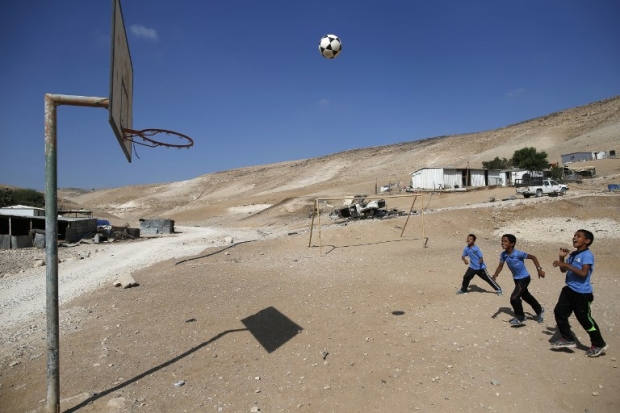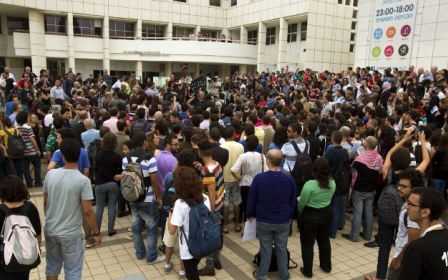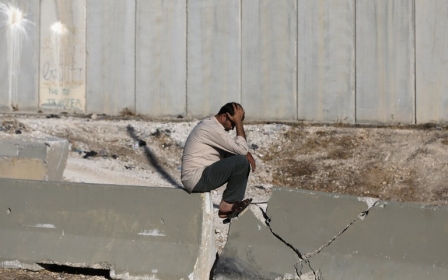
Divide and rule: How the school system sows division among Israel's Palestinians
The education system in Israel is one of the many areas where Arab Palestinian and Jewish citizens of Israel are segregated from each other as the schools are strictly divided into different sectors, based on both religion and ethnicity.
The system in its current form was established in 1953 with the State Education Law which provides the legal framework for the establishment of two sectors: a Jewish secular and a Jewish religious one. While the Palestinian minority is not mentioned in this law, the establishment of an Arab school sector that is separate from the two Jewish ones followed rather inevitably from it.
The Israeli education system can be seen as a political tool used by the government to advance its goals of furthering the Jewish character of the state rather than to provide the best possible education for all citizens
Despite an amendment of the law in 2000, the Arab sector has no official legal standing, but exists alongside the two ‘official and recognised’ Jewish sectors as an ‘unofficial but recognised’ one. Thus, from the inception of the state school system in 1953, Arab Palestinians and Jewish Israelis were generally prevented from attending school together.
Recent efforts of singling out the Arab Christian population in Israel regarding conscription and education suggest that the education system in its current form is more than just a provider of knowledge for the citizens of the state. The Ministry of Education has complete control over the school curricula of all types of schools – Jewish, Druze and Arab public and private, from kindergarten to high school.
Therefore, the education system can be seen as a political tool used by the government to advance its goals of furthering the Jewish character of the state rather than to provide the best possible education for all citizens.
The divisions created among the Palestinians with Israeli citizenship will also have consequences for the wider Palestinian quest for statehood and self-determination. Therefore, dividing the Palestinian communities into one inside and one outside of Israel, as I have done for this piece, is purely for the purpose of analysis and does not intend to undermine the concept of a collective Palestinian nation.
Steering Druze away
The main and most apparent active interventions by Israel in the education system in order to divide its Palestinian population are the attempts to separate the community based on their religion.
Divide-and-rule as a practice within the education system dates back to 1956 when a separate school system for the Druze in Israel was established. This development has to be seen in the broader context of Israel trying to single out the Druze community as ‘a people apart’, not belonging to the Palestinian community in any way.
Instead, the Druze’s loyalty to the state was emphasised and ensured by conscribing all male Druze to the Israeli army and promoting it in Druze schools. Therefore, as Ra’afat Harb, a Druze political activist told me this past summer, both atmosphere and curriculum in Druze schools differ from the one in other Arab Palestinian schools.
The result of the segregated, limited and biased education in Druze schools is that Druze identity is being remodeled in a way that suits the goals of the state and the Jewish majority. Of course, identity is always a shifting concept that differs individually and collectively and that can manifest itself in various ways. Again, according to Harb, there are Druze who identify as Palestinians, as Arabs, as Israelis or even as Zionists.
However, through the education system, the state actively suppresses the development of the Druze’s Arab and Palestinian identity and instead imposes a separate uniquely Druze/Israeli identity on them. In doing so, the state clearly follows an agenda of steering the Druze away from the Arab Palestinian community.
Challenges for Bedouin Arabs
Another major division that is created within the Palestinian community in Israel is between Christian/Muslim Arabs on the one side and Bedouin Arabs on the other side.
Most Bedouins in Israel live in the Naqab (Negev) in the south of the country where they face abject living conditions as a result of Israel’s attempt to uproot them from their land and to relocate them in a few concentrated villages and towns.
As inhabitants of the unrecognised villages, the Bedouins suffer from the poorest living conditions in the country, according to Noga Dagan-Buzaglo, a researcher at Adva Center – Information on Equality and Social Justice in Israel.
Because parents can face legal prosecution if they fail to send their children to school, some families have moved from the unrecognised to the recognised villages in order to facilitate school attendance and to avoid criminal charges, according to Muhammad Zidani, a researcher, and Muna Haddad, a lawyer, both with Adalah, the Legal Centre for Arab Minority Rights in Israel.
Here again, education is used as a political tool to force the will of the state unto its Arab citizens, in this case by removing parts of the population from its ancestral land.
Singling out Christian Arabs
A third, fairly recent development is the attempt of Israel to single out the Christian Arabs as they have done with the Druze for the past 60 years.
In 2013, state efforts increased to encourage Christian Arabs to join the Israeli military, taking advantage of the fact that they are numerically inferior to the Muslim Arabs and trying to create fear of a “growing ‘Muslim threat’ in the region”. Related is the current effort by the state to ascribe the Christian Arabs a new Aramaic ethnicity.
Odna Copty, who works for the Follow-Up Committee on Arab Education (FUCAE), says Christian Arabs like her are now described as Aramaic instead of Arab.
“They say that we are a group of different religions and have nothing in common," she said. "When I speak with somebody else who is Arab, it will never occur to me to actually ask him about his religion because culturally, it is not polite for Arabs to ask somebody about that.”
The attempt of the state to single out Christians and make them adopt a new Aramaic identity has not yet taken hold among the people. On the contrary, many Arab Palestinians like Copty mock these efforts as being unnatural and bound to fail.
However, the past shows that similar efforts have been successful in the Druze context. Therefore, this new divide-and-rule strategy should be taken seriously instead of being dismissed out of hand as absurd.
Someone else's history
The second important area in which the state directly implements its divide-and-rule policy is the content pupils learn in schools. The whole education system is based “on the values of Jewish culture and the achievements of science, on love of the homeland and loyalty to the State and the Jewish people (…)” as laid out in the 1953 State Education Law.
Bedouin schools are considered to be well-equipped if they consist of buildings made of brick with running water and electricity.
In practice, this means that the curricula designed for the Jewish secular and religious sectors aim at teaching pupils the Jewish Zionist values and point of view. As a result, Arab Palestinian pupils do not learn anything about their own people’s history or culture during the 14 years that they attend school.
Furthermore, the image of Arab Palestinians that is portrayed to them in the school books is negative, if not outright racist one.
Differences among Arab Palestinians are highlighted in a new controversial civics textbook, introduced by the current Minister of Education Naftali Bennett in May.
Despite pronounced protest by the Arab Palestinian community, Bennett insisted on the publication of the book that, among others, “needlessly divid[es] between Israel’s Muslim, Christian, Aramean and Druze segments and focusing more attention on the latter’s army service than on the largest subgroup”, namely Muslim Arabs.
Connected to this issue is the appointment of teachers and principals in Arab schools. Among the Palestinian community in Israel, it is commonly known that the Ministry of Education does not appoint the individual most suited for the task but the one that cooperates with the state.
The fact that the Shabak (Shin Bet), Israel’s internal security service, is involved in the appointment – and the preceding screening - of the teachers and principals shows how crucial Israel considers the appointment of the ‘right’ people to be. By choosing loyal or at least not openly critical teachers and principals, the state makes sure that only the content provided for in the school curriculum will be taught. Even in private schools, that have a certain degree of freedom regarding the appointment of teachers and the content, the teachers are aware of their role within the system and mainly stick to the dominant narrative.
All these aspects taken together ensure that the state, by direct intervention in the education system, transmits only the dominant Zionist narrative that is supposed to protect the Jewish character of the state. This practice aims at sowing divisions among Arab Palestinian pupils because it denies the existence of a Palestinian nation and instead emphasises all aspects that separate the community on religious or other terms.
Nice education - if you can afford it
Israel also tries to undermine the cohesion among the Arab Palestinian community in a more indirect, subtle way. While the exact numbers vary, it is obvious that the Ministry of Education allocates much less funds to Arab schools than to Jewish ones, resulting in a severe lack of resources in all Arab public schools.
Bedouin schools are considered to be well-equipped if they consist of buildings made of brick with running water and electricity. As a result of the persistent work of FUCAE, the Ministry of Education is fully aware of the amount of money needed annually per student to close the gap between Jewish and Arab students.
According to FUCAE’s General Director Aatef Moadei, however, Israel is interested in managing the gaps rather than closing them. The indifference of the state is all the more remarkable when considering that it is directed against people who make up 20 percent of its own citizenry, all of whom pay taxes and expect to see meaningful investments in return.
The school system, as it currently exists, clearly caters to the best interests of the state rather than the students.
As a result of the lack of funding and the poor infrastructure in most public schools, Arab private schools have become the preferred alternative for parents who want their children to receive a better education. Most Arab private schools are run and partly funded by churches, which means that they have more funds to draw on and which gives them more freedom in handling the internal affairs of the school. Arab Church schools are open to all Arab pupils, not only Christians.
However, as parents pay tuition fees for these schools, poorer Arab families who are generally Muslim, are excluded from this alternative. As a result, by intentionally underfunding the public schools and forcing the Arab community to divert to private education that is partly self-paid, the state again enforces a separation of the community based on religion, in addition to highlighting the stratification along the lines of class.
Keeping students undereducated
The state’s strategy regarding the Arab education system seeks to ensure that the Palestinian citizens in Israel remain undereducated whilst providing enough education to mask the reality to both the international community and the Israeli public.
The severe deficits in the school system result in low participation of Arabs in higher education: only one in every four Arab pupils goes on to higher education, compared to one out of every two Jewish pupils. As a result, the direct and indirect measures sustained by the state do not only lead to the reinforcement of differences within the Arab Palestinian community.
On a greater scale, these measures also result in a system that produces a relatively low-skilled labor force, for example by producing badly trained Arab teachers that, in turn, will have an effect on the next generation of Arab Palestinian pupils – ensuring a continued marginalisation of the Palestinian minority within Israel.
Democracy in name only
The state thus interferes directly and indirectly with the Arab education sector and aims at enforcing separations among the Arab Palestinian citizens in Israel based on ethnicity, religion, geography and class. The school system, as it currently exists, clearly caters to the best interests of the state rather than the students.
it is of crucial importance that Israel starts treating all its citizens, Jews and non-Jews, equally if it wants to continue calling itself and being called a democracy
Palestinians in Israel are aware of their community’s diversity. However, they claim that the government uses the education system to reinforce the existing differences, which would not be so problematic if not stressed continuously by the state. The control of their schools by the Ministry of Education and especially the complete lack of freedom regarding the content that is being taught are two practices they widely rejected.
Therefore, the Arab Palestinian community in Israel demands complete autonomy for the Arab educational sector, by taking over full responsibility for the allocation of funds, the content of the curricula and the appointment of teachers in all Arab schools.
The autonomy of the Arab educational sector in Israel would be an important step towards the improvement of Arab education in general. Moreover, it would provide a chance for the Arab Palestinian citizens in Israel to halt the state’s attempts to divide them into ever smaller communities in order to jeopardise the Palestinian national movement.
While these goals might appear to be utopian, it is of crucial importance that Israel starts treating all its citizens, Jews and non-Jews, equally if it wants to continue calling itself and being called a democracy.
- Mona Bieling is a graduate student in International History at the Graduate Institute of International and Development Studies (IHEID) in Geneva, Switzerland. This research was carried out with support of Baladna - Association for Arab Youth in Haifa, Israel.
The views expressed in this article belong to the author and do not necessarily reflect the editorial policy of Middle East Eye.
Photo: A Palestinian teacher leads a class of Palestinian bedouin children from the Abu Nawar community near the Jewish settlement of Maale Adumim (background), in the West Bank town of al-Azariya, east of Jerusalem, on 23 February 2016 (AFP)
New MEE newsletter: Jerusalem Dispatch
Sign up to get the latest insights and analysis on Israel-Palestine, alongside Turkey Unpacked and other MEE newsletters
Middle East Eye delivers independent and unrivalled coverage and analysis of the Middle East, North Africa and beyond. To learn more about republishing this content and the associated fees, please fill out this form. More about MEE can be found here.






